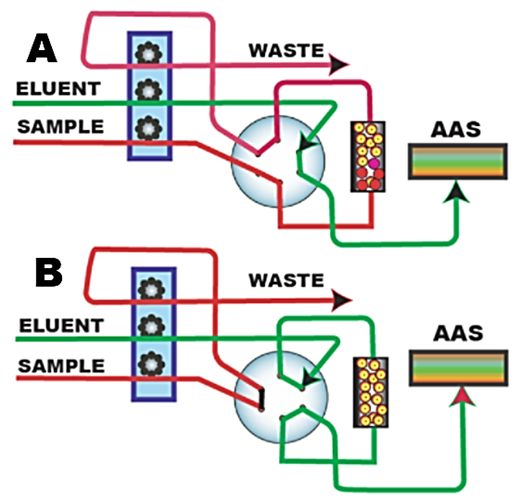2.1.7. Separation methods performed at continuous flow
Continuous flow format is well suited for automation of separation techniques, used to enrich concentration of target analyte and/or to remove matrix interference:
- Solvent extraction
- Sorbent extraction
- Gas diffusion and dialysis
- Hydride generation
Of these techniques Sorbent Extraction and Gas Diffusion are most widely used.
Automation of Sorbent Extraction by Flow Injection is based on analyte accumulation (A), whereby a defined volume of sample is passed through the column, followed by analyte elution (B). There are many examples of automated sorbent extraction protocols for trace metal analysis for environmental and oceanographic research. (Miro and Hansen 2006, Motomizu 2008).
 When a microcolumn is nested in a valve, the captured sample volume is determined by flow rate and by time during which the target analyte is accumulated on the column, By switching the valve, the accumulated analyte is eluted , by reversed flow from the column into the Atomic Absorption Spectrophotometer for quantification.
When a microcolumn is nested in a valve, the captured sample volume is determined by flow rate and by time during which the target analyte is accumulated on the column, By switching the valve, the accumulated analyte is eluted , by reversed flow from the column into the Atomic Absorption Spectrophotometer for quantification.
Typical applications are trace element assays (Pb, Cd, Cu, Ni, Zn, Mn, Al, Cr. Ti, V, Ce, Co etc), by either Atomic Absorption or by ICP-MS. The analyzed materials range from sea water to fertilizers and biological samples.
The majority of SE methods has been designed to quantify the target analyte in an eluate, while the system is operated in the continuous flow mode. This approach presents several challenges when optimizing the assay protocol because analyte adsorption, analyte elution and system wash are best performed at different flowrates.
Gas diffusion techniques are used for separation of volatile species form aqueous solutions. A sample injected into a donor stream (blue) enters a planar diffuser where a hydrophobic membrane, serving as air gap, transfers selectively ammonia, carbon dioxide, sulfur dioxide, chlorine, ozone, hydrogen cyanide, ethanol, acetic acid, hydrofluoric and hydrochloric acid as well as many other volatile compounds, into acceptor stream (green). (Luque de Castro 1998, 2008) For spectrophotometric measurement, which is most frequently used, acceptor stream is made of chromogenic reagent. Replacing the constant flowrate by programmed flowrate allows miniaturization of gas diffusion module and increases sensitivity of an assay.

M. Miro, W.Frenzel, “A critical Examination of SPE preconcentration with spectrophotometric sensing in flowing streams” Talanta 64, (2004) 294.
M. Miro, E.H.Hansen, “Solid reactors in sequential injection analysis. The recent trends in the environmental field” TrAC Vol. 25.No.3, (2006) 267.
S. Motomizu and T. Sakai “On line sample pretreatment ”in: Advances In Flow Injection Analysis and Related Techniques, S.D. Kolev and Ian McKelvie
M. D. Luque de Castro & I. Papaefstathiou, "Analytical pervaporation: a new separation technique", TRAC, 17, 41, (1998)
M.D. Luque de Castro , "Membrane Based Separation Techniques, Dialysis, Gas Diffusion and Pervaporation." in Comprehensive Analytical Chemistry